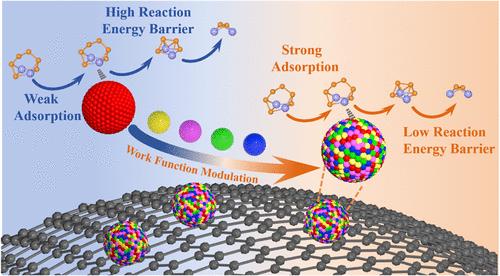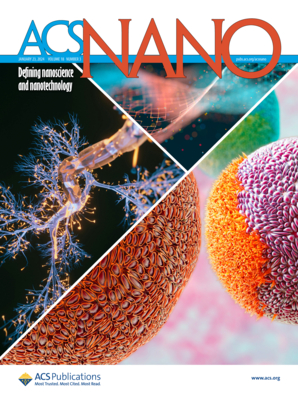High Rate and Long-Cycle Life of Lithium–Sulfur Battery Enabled by High d-Band Center of High-Entropy Alloys
IF 15.8
1区 材料科学
Q1 CHEMISTRY, MULTIDISCIPLINARY
引用次数: 0
Abstract
Efficient catalysis of intermediate lithium polysulfide (LiPS) conversion in lithium–sulfur batteries is crucial for enhancing sulfur reduction reaction (SRR) kinetics and suppressing the shuttle effect of LiPSs. High-entropy alloys (HEAs), with their compositional flexibility, structural diversity, and multielement synergy, are promising high-efficiency catalyst candidates. Herein, a work function-dominated d-band center rule is proposed to modulate the chemical absorption ability of LiPSs and the catalytic performance of HEA catalysts. The d-band center of the as-screened PtCuFeCoNi HEAs (PCFCN–HEAs) is modulated via distinct work functions of its five metallic elements. In addition, detailed density functional theory (DFT) calculations and X-ray absorption spectroscopy are performed to reveal the roles of individual metallic elements in HEAs. Optimizing the d-band center of PCFCN–HEAs notably enhances the adsorption of LiPSs and accelerates the SRR. PCFCN–HEA nanoparticles are deposited on the surface of hollow carbon spheres (HCSs) and they combine with hyphae carbon nanobelts (HCNBs) to form a PCFCN–HEA/HCS/HCNB composite as the sulfur host. The cathode with PCNFC-HEA catalyst exhibits stable cycling at 6C and delivers a high reversible capacity of 652 mAh g–1 even at a high rate of 8C. DFT calculations further elucidate the stepwise catalytic mechanism of PCFCN–HEAs, offering a pathway for designing high-efficiency catalysts.

求助全文
约1分钟内获得全文
求助全文
来源期刊

ACS Nano
工程技术-材料科学:综合
CiteScore
26.00
自引率
4.10%
发文量
1627
审稿时长
1.7 months
期刊介绍:
ACS Nano, published monthly, serves as an international forum for comprehensive articles on nanoscience and nanotechnology research at the intersections of chemistry, biology, materials science, physics, and engineering. The journal fosters communication among scientists in these communities, facilitating collaboration, new research opportunities, and advancements through discoveries. ACS Nano covers synthesis, assembly, characterization, theory, and simulation of nanostructures, nanobiotechnology, nanofabrication, methods and tools for nanoscience and nanotechnology, and self- and directed-assembly. Alongside original research articles, it offers thorough reviews, perspectives on cutting-edge research, and discussions envisioning the future of nanoscience and nanotechnology.
 求助内容:
求助内容: 应助结果提醒方式:
应助结果提醒方式:


